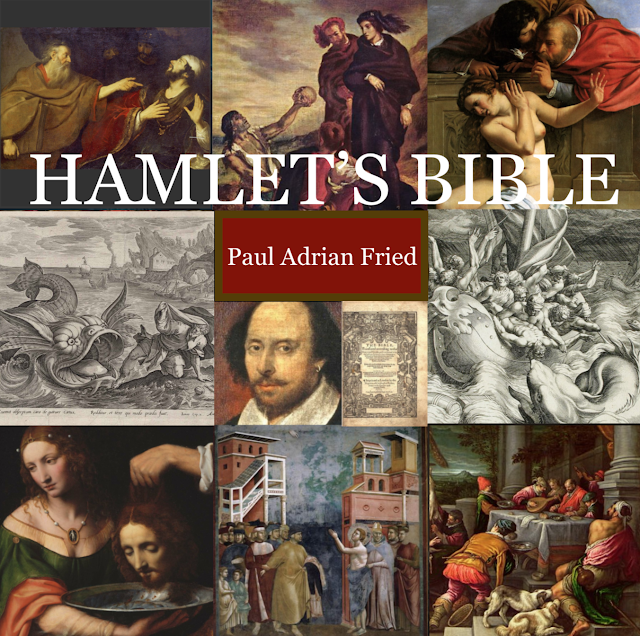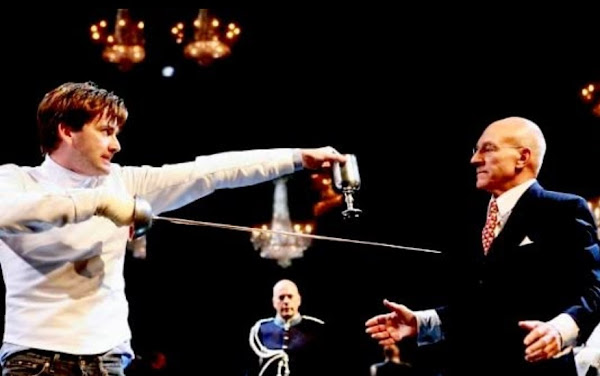Does Shakespeare’s Hamlet depict religiously shaped or motivated regicide?
[David Tennant (L) as Hamlet and Patrick Stewart (R) as Claudius in the 2009 film, Hamlet, dir. Gregory Doran. Source: IMDB. Fair use.]
Dr. Arthur F. Marotti gave a talk at Fordham in late October of 2013 in which he noted, “In the last years of Elizabeth’s rule people believed something was rotten in England—though perhaps not rotten enough to justify regicide.” [2]
Marotti has written numerous books [3] about Early Modern literature and religion, including a 2004 essay with Ken Jackson on “The Turn to Religion” in Shakespeare studies.
In an abstract for a more recent (2017) essay [4], Marotti notes that “Shakespeare's plays may not stage religiously motivated regicides…,” with “may” being the operative word here: Scholars may disagree on this point.
But what about Hamlet?
Recognizing that Hamlet's motives incl. religious ones is not the same as saying Shakespeare endorsed religiously-motivated regicide. He depicts Hamlet as a prince and heir deprived of the throne by a murderous usurper.
If you're going to do a play about religiously motivated regicide, this is safe.
Many religious or biblical references in Hamlet are explicit: Cain’s murder of Abel (“first corse,” 1.2; “A brother’s murther!” 3.3; “Cain’s jawbone,” 5.1); Jephthah who sacrificed his daughter (2.2). [5]
Others are more subtle, including echoes of the David and Bathsheba tale [6], where David sends a letter with Uriah to covertly arrange for his death (3.4, 4.3); and of the prophet Nathan who catches the conscience of the king (2.2) in a story; and of Herod Antipas (3.2) who ordered the beheading of the prophet John (“Baptista”) [7].
Claudius’ prayer scene (3.3) parodies Christ’s agony in the garden, and alludes to Ps. 51, the prayer of David repenting of his murder of Uriah, while Hamlet sparing Claudius parodies David sparing Saul in the cave at En Gedi (1 Sam 24). [8]
The ghost gives commands to Hamlet like God to Moses, and describes how the poison made his skin “lazar-like” (leperous, 1.5), resembling that of the beggar Lazarus who had sores all over his body that were licked by dogs, and who was neglected by the rich man. [9]
There are numerous allusions to the mass, and Jesus’ command to “do this in memory of me” (1.5), as well as a parody of the body of Jesus missing from the tomb (4.2, 4.3, John 20:13-15) [10], and to Martin Luther (Wittenberg, 1.2) and the Diet of Worms (4.3).
Hamlet has a Jonah-like sea-voyage where he changes mode of transportation mid-sea to a pirate ship (4.6) instead of a fish, and comes to believe Providence is on his side. [11]
Instead of two disciples on the road to Emmaus meeting a stranger who reminds them of Jesus, Hamlet and Horatio, two Danes on the road to Elsinore, meet a gravedigger who reminds Hamlet of Yorick, fool of “infinite jest” (5.1). [12]
Hamlet views himself as “scourge and minister” (3.4) but after his sea-voyage and graveyard encounters, he kills Claudius, reconciles with Laertes, and gives his dying voice to Fortinbras, another Jephthah figure. [13]
One may argue that Shakespeare and some in his audiences are more aware of more of the religious and biblical allusions than any one character seems to be, including Hamlet - a wonderful point - and yet Hamlet's sense of himself as "scourge and minister" and of his "readiness" ("Let be") is a religious sense of self.
Is Hamlet’s killing of Claudius religiously shaped or motivated? I think so.
~~~~~
NOTES:
[1] Perhaps a religiously-motivated Hamlet only scratches him, and lets him kill himself with the poison cup, as in the Gregory Doran's 2009 production with David Tennant and Patrick Stewart, based on previous scholarly exploration of the scene: In a 1988 article in Hamlet Studies, David C.H. Morgan proposed that, instead, Hamlet only scratches Claudius with the poison sword to give him a taste of his own medicine, and then offers the cup to Claudius, which he takes to end his own life. See: Morgan, David C.H. “‘When mercy seasons justice’: How and (Why) Hamlet Does Not Kill Claudius.” Hamlet Studies 10.1-10.2 (1988): 47-78.
http://triggs.djvu.org/global-language.com/ENFOLDED/index.php?page=texts.php?sects=studies
[2] https://news.fordham.edu/arts-and-culture/shakespeare-papal-power-and-the-death-of-kings/
[3] Dr. Arthur F. Marotti, an alumnus of Fordham College at Rose Hill (‘61), is Distinguished Professor Emeritus of English at Wayne State University and has written a number of books and essays on Early Modern literature, a few of them specifically about religion, including
an important 2004 essay with Ken Jackson, “The Turn to Religion,”
a 2005 book, Religious Ideology and Cultural Fantasy: Catholic and Anti-Catholic Discourses in Early Modern England
https://undpress.nd.edu/9780268034801/religious-ideology-and-cultural-fantasy/
and also with Jackson, he edited the 2011 collection, Shakespeare and Religion: Early Modern and Postmodern Perspectives.
https://undpress.nd.edu/9780268032708/shakespeare-and-religion/
[4] “Religion, Secularity, and Shakespeare,” by Arthur F. Marotti and Ken Jackson, chapter 31 in The Shakespearean World, Ed. Jill L. Levenson and Robert Ormsby.
https://www.taylorfrancis.com/chapters/edit/10.4324/9781315778341-32/religion-secularity-shakespeare-arthur-marotti-ken-jackson?context=ubx&refId=d869e8c5-1013-4988-a865-22776f8b0738
[5] Starting in October of 2020, I did a multi-part series on the Jephthah allusion in Hamlet, in which I was surprised to find how the few details we learn about Fortinbras correspond to elements in the Jephthah story:
https://pauladrianfried.blogspot.com/2021/02/jephthah-series-pay-attention-be-astonished-tell.html
[6] See the following blog post for a quick overview of correlations:
https://pauladrianfried.blogspot.com/2017/09/hamlet-has-david-complex-freud-claimed.html
See also The David Myth in Western Literature, eds. Raymond-Jean Frontain, Jan Wojcik, 1980, 70-85, http://www.thepress.purdue.edu/titles/david-myth-western-literature
and The Bible in Shakespeare, Hannibal Hamlin, 2013, 119-120,
https://oxford.universitypressscholarship.com/view/10.1093/acprof:oso/9780199677610.001.0001/acprof-9780199677610 for just two examples.
In a Google search, keywords [Hamlet David Bathsheba] turn up multiple references, including study guides directing student-readers of Hamlet to consider the David-Bathsheba story.
[7] Hamlet instructs the players not to overplay lines: it “out-Herods Herod.” Many readers (and editors) on this point think only of Herod the Great who slaughtered the innocents. But in the play-within-the play, “The Mousetrap,” Hamlet names one character as “Baptista.” Herod, Baptista. Some early editors and commentators debated whether “Baptista was just a common name, or mere allusion to Italian intrigue, but Joseph Ritson (1752 – 1803) is cited in early variorum editions as claiming that it was a reference to the biblical prophet. It seems Shakespeare follows his own advice, not over-doing explicit biblical references: Don’t out-Herod Herod.
For general information on the Herod-Baptista connection, see the following post:
https://pauladrianfried.blogspot.com/2018/11/hamlet-which-herod-which-baptista-in.html
and also here:
https://pauladrianfried.blogspot.com/2018/11/hamlet-footnotes-in-need-of-updates.html
[8] See this post:
https://pauladrianfried.blogspot.com/2019/01/hamlet-prayer-scene-ironic-clashing.html
[9] For more on the ghost, Hamlet, and Moses, see Julia Reinhard Lupton, Thinking with Shakespeare: Essays on Politics and Life ("Hamlet plays Moses to the ghost's God...").
The visit of Hamlet to encounter the ghost also resembles the transfiguration, where Jesus goes off alone and is transfigured, but two disciples witness it (Mt 17:1–8; Mk 9:2–8; Lk 9:28–36).
For more on that, see this post:
https://pauladrianfried.blogspot.com/2019/04/dark-transfiguration-moses-echoes-in.html
In 2018, I posted about how I found at least seven parallels in Hamlet with the bible tale of the rich man and the beggar Lazarus:
https://pauladrianfried.blogspot.com/2018/01/the-ghost-of-lazarus-haunts-hamlet.html
I later did a 16-part series exploring other aspects of the Lazarus allusion:
https://pauladrianfried.blogspot.com/2021/02/new-series-on-rich-man-lazarus.html
[10] See the heading, ‘ADDING TO THE SOURCE TALE AN ECHO OF JOHN 20:13-15, "WHERE HAVE THEY TAKEN HIM?"’ in the following post:
https://pauladrianfried.blogspot.com/2021/06/kings-beggars-worms-excrement-eucharist.html
[11] In April of 2018, I offered the following observations on the correlations between the biblical Jonah tale and that of Hamlet’s sea-voyage:
https://pauladrianfried.blogspot.com/2018/04/the-ghost-of-jonah-haunts-hamlet.html
[12] in May of 2018, I offered the following observations on correlations between the biblical tale of the appearance of Jesus to the disciples on the road to Emmaus, and Hamlet and Horatio’s visit with the gravedigger and tales of Yorick:
https://pauladrianfried.blogspot.com/2018/05/emmaus-in-hamlet-in-emmaus-story-1.html
[13] In my series on the Jephthah allusion, this post in particular considered how Fortinbras, surprisingly, fits many aspects of the Jephthah tale:
https://pauladrianfried.blogspot.com/2020/12/jephthah-polonius-cecil-ambitious.html
~~~~~~~~~~~~~~~~~~~~~~~~
Disclaimer: If and when I quote or paraphrase bible passages in many of my blog posts, I do not intend to promote any religion over another, nor am I attempting to promote religious belief in general; only to point out how the Bible may have influenced Shakespeare, his plays, and his age.
~~~~~~~~~~~~~~~~~~~~~~~~
Thanks for reading!
My current project is a book tentatively titled Hamlet’s Bible, about biblical allusions and plot echoes in Hamlet.
Below is a link to a list of some of my top posts (“greatest hits”), including a description of my book project (last item on the list):
https://pauladrianfried.blogspot.com/2019/12/top-20-hamlet-bible-posts.html
I post every week, so please visit as often as you like and consider subscribing.


Claudius’ prayer scene (3.3) parodies Christ’s agony in the garden, and alludes to Ps. 51, the prayer of David repenting of his murder of Uriah, while Hamlet sparing Claudius parodies David sparing Saul in the cave at En Gedi (1 Sam 24). [8]
ReplyDeleteThe ghost gives commands to Hamlet like God to Moses, and describes how the poison made his skin “lazar-like” (leperous, 1.5), resembling that of the beggar Lazarus who had sores all over his body that were licked by dogs, and who was neglected by the rich man. [9]
Priceless research and essential argument! I could write a thesis on almost every biblical reference, especially the OT ones.
Thank you, Paul.
Thanks, Michael. And as my footnotes show, I'm indebted to many others for quite a bit of that, and if I'm not yet aware of others before me who have already made observations similar to what I don't credit in the footnotes, that doesn't mean others haven't arrived at many of the same insights before me....
Delete